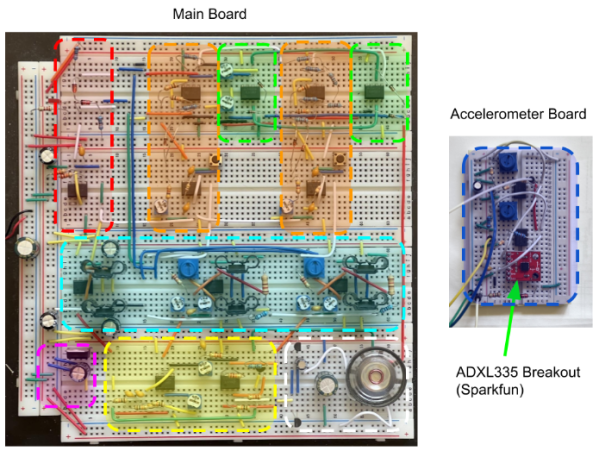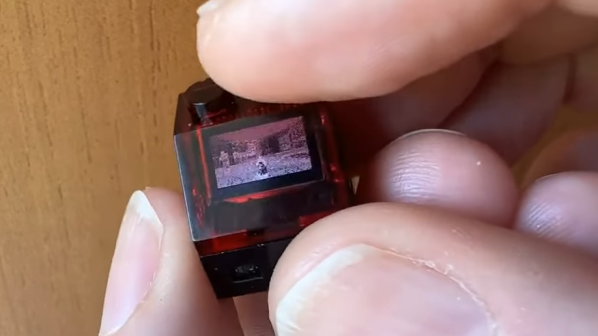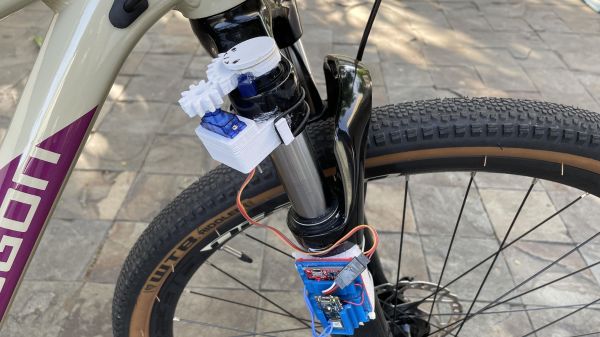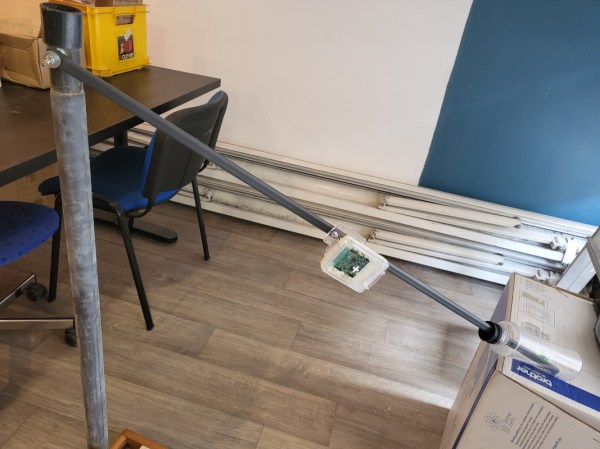GPS has changed the way we get around the globe. But if you command a warship, you must think about what you would do if an adversary destroyed or compromised your GPS system. The Royal Navy and Imperial College London think a quantum navigation system might be the answer.
Of course, Heisenberg says you can’t know your speed and position simultaneously. But at the real-world level, you can apparently get close enough. The quantum sensors in question are essentially accelerometers. Unlike conventional accelerometers, though, these devices use ultracold atoms to make very precise measurements using a laser optical ruler, which means they do not drift as rapidly as, say, the accelerometer in your phone. Navigating with accelerometers is well understood, but the issue is how often you have to correct your computed position with an actual reference due to drift and other error accumulation. You can see a Sky News report on the trial below. Continue reading “Royal Navy Tests Quantum Navigation”
accelerometer178 Articles
Op-Amp Challenge: Virtual Ball-in-a-Box Responds To Your Motions
With the incredible variety of projects submitted to our Op-Amp Contest, you’d almost forget that operational amplifiers were originally invented to perform mathematical operations, specifically inside analog computers. One popular “Hello World” kind of program for these computers is the “ball-in-a-box”, in which the computer simulates what happens when you drop a bouncy ball into a rigid box. [wlf647] has recreated this program using a handful of op amps and a classic display, and added a twist by making the system sensitive to gravity.
All the physics simulation work is performed by a set of TL072 JFET input op amps. Four are configured as integrators that simulate the motion of the ball in the X and Y directions, while four others serve as comparators that detect the ball’s collisions with the edges of the box and give it a push in the opposite direction. Three more op amps are connected to form a quadrature oscillator, which makes a set of sine and cosine waves that draw a circle representing the ball.
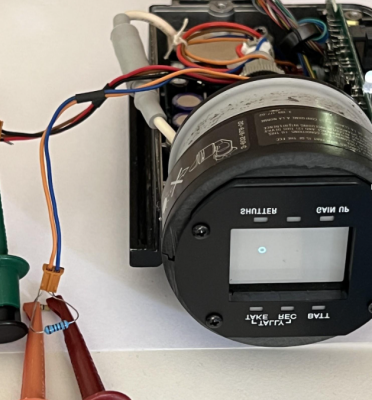 The simulator’s output signals are connected to a tiny viewfinder CRT as well as a speaker that makes a sound whenever the ball hits one of the screen’s edges. This makes for a great ball-in-box display already, but what really makes this build special is the addition of an analog MEMS accelerometer that modifies the gravity vector in the simulation.
The simulator’s output signals are connected to a tiny viewfinder CRT as well as a speaker that makes a sound whenever the ball hits one of the screen’s edges. This makes for a great ball-in-box display already, but what really makes this build special is the addition of an analog MEMS accelerometer that modifies the gravity vector in the simulation.
If you tilt or shake the sensor, the virtual box experiences a similar motion, which gives the simulation a beautiful live connection to the real world. You can see the result in a demo video [wlf647] recently posted.
The whole setup is currently sitting on a solderless breadboard, but [wlf647] is planning to integrate everything onto a PCB small enough to mount on the viewfinder, turning it into a self-contained motion simulator. Analog computers are perfect for this kind of work, and while they may seem old-fashioned, new ones are still being developed.
Magic 8 Ball Provides Tech Support
ChatGPT might be making the news these days for being able to answer basically any question it’s asked, those of us who are a little older remember a much simpler technology that did about the same thing. The humble “Magic 8 Ball” could take nearly the same inputs, provided they were parsed in simple yes/no form, and provide marginal help similar to the AI tools of today. For a toy with no battery or screen, this was quite an accomplishment. But the small toy couldn’t give specific technical support help, so [kodi] made one that can.
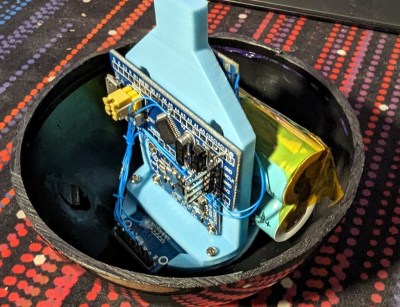 The new 8 Ball foregoes the central fluid-filled chamber for an STM32 Blue Pill board with a few lithium batteries to power it. The original plastic shell was split in two with a hacksaw and fitted with a 3D printed ring which allows the two halves to be reconnected and separated again when it needs to charge. It uses a circular OLED to display the various messages of tech support, which are displayed when an accelerometer detects that the toy has been shaken.
The new 8 Ball foregoes the central fluid-filled chamber for an STM32 Blue Pill board with a few lithium batteries to power it. The original plastic shell was split in two with a hacksaw and fitted with a 3D printed ring which allows the two halves to be reconnected and separated again when it needs to charge. It uses a circular OLED to display the various messages of tech support, which are displayed when an accelerometer detects that the toy has been shaken.
Granted, most of the messages are about as helpful to solving a tech support issue as the original magic 8 Ball’s would have been, but we appreciate the ingenuity and carefree nature of a project like this. It also did an excellent job at operating in a low-power state as well, to avoid needing to charge it often. There have been a few other digital conversions of these analog fortune tellers as well, like this one which adds GIFs to each of the original answers.
DOOM Ported To A Single LEGO Brick
By now you’ve all seen the tiny LEGO brick with a working screen in it. The work of one [James “Ancient” Brown], it was truly a masterpiece of miniaturization and creativity. Since then, [James] hasn’t stopped innovating. Now, he’s demoing a playable version of DOOM running on a single plastic brick.
We’ve covered the construction of these astounding screen bricks before. Long story short, [James] designed a tiny PCB that hosts an RP2040 microcontroller which is then hooked up to a tiny OLED screen. The components are placed in a silicone mold, which is then filled with transparent resin to form the brick. The screen is then powered via contacts in the bottom, much like older-style LEGO motors.
Early experiments involved running various graphics to emulate a spaceship dashboard, but [James] has now gone much further. He’s implemented RP2040-doom to run the game. It uses tilt controls thanks to an accelerometer, combined with capacitive touch controls for shooting. The monochrome OLED is driven very fast with a special library of [James’] own creation to create three levels of grayscale to make the game actually visible and (just barely) playable.
It’s a hack, of course, and the controls are far from perfect. Nobody’s speed-running E1M1 on [James’s] LEGO brick, to be sure. Perchance. With that said, it’s still a glorious piece of work nonetheless. Just imagine, sitting with friends, and announcing you’re going to play some DOOM — only to pluck a piece of LEGO out of your pocket and start blasting away at demons.
Just because [James] doesn’t know when to quit, we’re going to lay down the gauntlet. Let’s get network play happening on these things, yeah?
Continue reading “DOOM Ported To A Single LEGO Brick”
Smart Bike Suspension Tunes Your Ride On The Fly
Riding a bike is a pretty simple affair, but like with many things, technology marches on and adds complications. Where once all you had to worry about was pumping the cranks and shifting the gears, now a lot of bikes have front suspensions that need to be adjusted for different riding conditions. Great for efficiency and ride comfort, but a little tough to accomplish while you’re underway.
Luckily, there’s a solution to that, in the form of this active suspension system by [Jallson S]. The active bit is a servo, which is attached to the adjustment valve on the top of the front fork of the bike. The servo moves the valve between fully locked, for smooth surfaces, and wide open, for rough terrain. There’s also a stop in between, which partially softens the suspension for moderate terrain. The 9-gram hobby servo rotates the valve with the help of a 3D printed gear train.
But that’s not all. Rather than just letting the rider control the ride stiffness from a handlebar-mounted switch, [Jallson S] added a little intelligence into the mix. Ride data from the accelerometer on an Arduino Nano 33 BLE Sense was captured on a smartphone via Arduino Science Journal. The data was processed through Edge Impulse Studio to create models for five different ride surfaces and rider styles. This allows the stiffness to be optimized for current ride conditions — check it out in action in the video below.
[Jallson S] is quick to point out that this is a prototype, and that niceties like weatherproofing still have to be addressed. But it seems like a solid start — now let’s see it teamed up with an Arduino shifter.
Continue reading “Smart Bike Suspension Tunes Your Ride On The Fly”
Bicycle Gets Turn Signals And Brake Lights For Added Safety
Traveling by bicycle can be a fun and exciting mode of transportation, and can also save a ton of money compared to driving a car. There are plenty of places around the world where a bicycle is the primary mode of transportation for a significant percentage of the population, but there are many more places that are designed entirely for cars with little thought given to anyone else. For anyone riding a bike, especially for people living in these car-dominated areas, additional safety measures like this LED array are often necessary.
The light array was created by [Estudio Roble] for traveling around his city. The design is based on the Adafruit Circuit Playground Express, which sits directly in the middle of the light fixture. Surrounding it is a diamond-shaped strip of LEDs within an additional ring. The light uses a bright blue color for normal driving, but is programmed to turn red when the accelerometer in the dev board detects braking. There are also integrated turn signals which operate similarly to motorcycle turn signals. The signal is sent wirelessly between the handlebar switch to the lights.
The device itself clips onto any backpack, and since the controller is wireless there are no wires to connect every time a rider gets on their bike. It’s quite an improvement over the complete lack of lighting on most bikes. If you’ve read this far, you need to check out this bicycle headlight which uses a projector to display information directly in the path of travel.
Continue reading “Bicycle Gets Turn Signals And Brake Lights For Added Safety”
Water Level Sensor Does Not Use Water Level Sensor
When interfacing with the real world, there are all kinds of sensors available which will readily communicate with your microcontroller of choice. Moisture, pH, humidity, temperature, location, light, and essentially every other physical phenomenon are readily measured with a matching sensor. But if you don’t have the exact sensor you need, it’s sometimes possible to use one sensor as a proxy for another.
[Brian Wyld] needed a way to monitor the level of a remote body of water but couldn’t use a pressure or surface-level sensor, so he used a sensor typically intended for geolocation instead. This particular unit, an STM-type device with a built-in accelerometer, is attached to a rotating arm with a float at one end. As the arm pivots, the microcontroller reports its position and some software converts the change in position to a water level. It’s also paired with a LoRa radio, allowing it to operate off-grid.
Whether there is a design requirement to use an esoteric sensor to measure something more common, or a personal hardware limitation brought about by a shallow parts drawer, there’s often a workaround like this one that can accomplish the job. Whatever the situation, we do appreciate hacking sensors into other types of sensors just as much as anything else.


